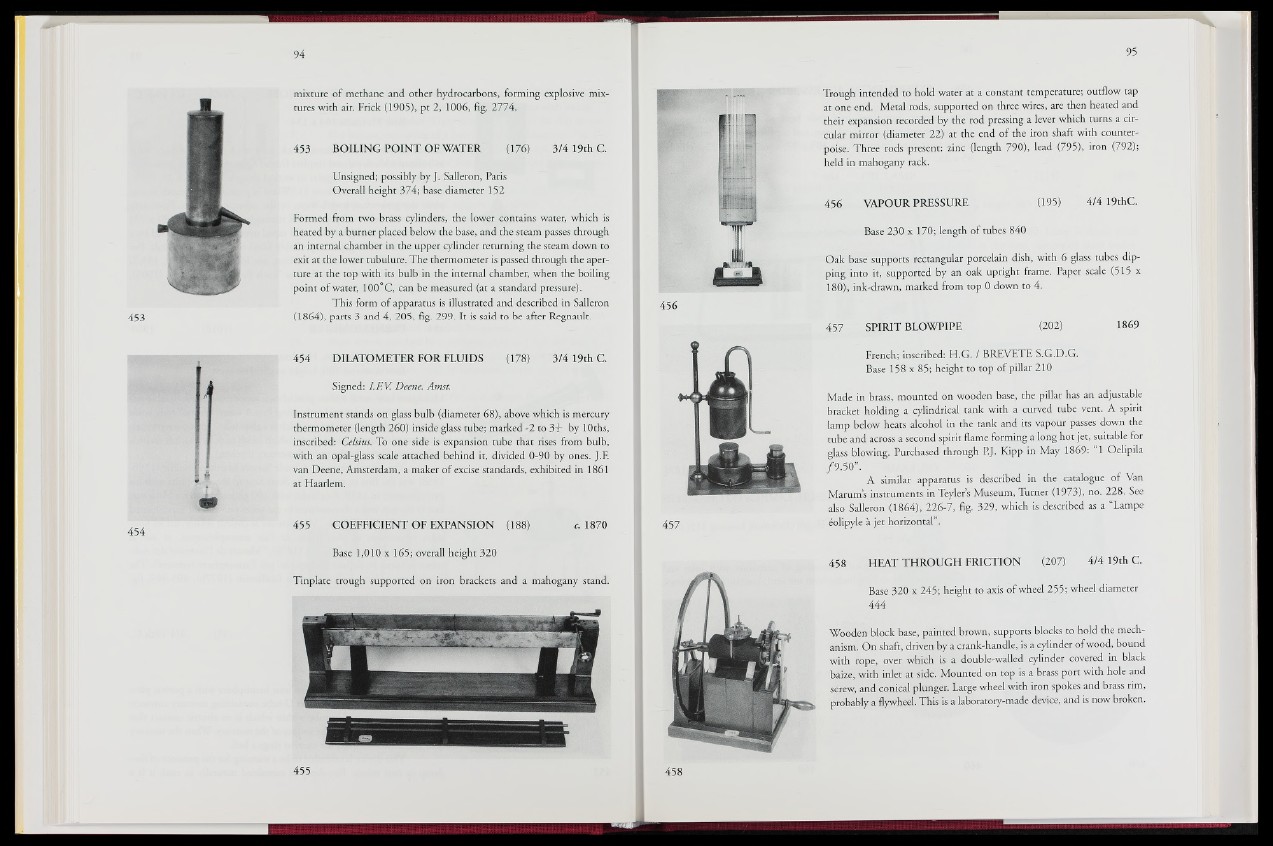
mixture of methane and other hydrocarbons, forming explosive mixtures
with air. Frick (1905), pt 2, 1006, fig. 2774.
453 BOILING POINT OF WATER (176) 3/4 19th G.
Unsigned; possibly by J. Salleron, Paris
Overall height 374; base diameter 152
Formed from two brass cylinders, the lower contains water, which is
heated by a burner placed below the base, and the steam passes through
an internal chamber in the upper cylinder returning the steam down to
exit at the lower tubulure. The thermometer is passed through the aperture
at the top with its bulb in the internal chamber, when the boiling
point of water, 100°C, can be measured (at a standard pressure).
This form of apparatus is illustrated and described in Salleron
(1864), parts 3 and 4, 205, fig. 299.'-I:t is said to be after Regnault.
454 DILATOMETER FOR FLUIDS (178) 3/4 19th C.
Signed: I.F.V. Deene. Amst.
Instrument stands on glass bulb (diameter 68), above which is mercury
thermometer (length 260) inside glass tube; marked -2 to 34" by lOths,
inscribed: Celsitis. To one side is expansion tube that rises from bulb,
with an opal-glass scale attached behind it, divided 0-90 by ones. J.F.
van Deene, Amsterdam, a maker of excise standards, exhibited in 1861
at Haarlem.
455 COEFFICIENT OF EXPANSION (188) c. 1870
Base 1,010 x 165; overall height 320
Tinplate trough supported on iron brackets and a mahogany stand.
Trough intended to hold water at a constant temperature; outflow tap
at one end. Metal rods, supported on three wires, are then heated and
their expansion recorded by the rod pressing a lever which turns a circular
mirror (diameter 22) at the end of the iron shaft with counterpoise.
Three rods present: zinc (length 790), lead (795), iron (792);
held in mahogany rack.
456 VAPOUR PRESSURE (195) 4/4 19thC.
Base 230 x 170; length of tubes 840
Oak base supports rectangular porcelain dish, with 6 glass tubes dipping
into it, supported by an oak upright frame. Paper scale (515 x
180), ink-drawn, marked from top 0 down to 4.
457 SPIRIT BLOWPIPE (202) 1869
French; inscribed: H.G. / BREVETE S.G.D.G.
Base 158 x 85; height to top of pj§ ^ 2 1 0
Made in brass, mounted on wooden base, the pillar has an adjustable
bracket holding a cylindrical tank with a curved tube vent. A spirit
lamp below heats alcohol in the tank and its vapour passes down the
tube and across a second spirit flame forming a long hot jet, suitable for
glass blowing. Purchased through P.J. Kipp in May 1869: OTOelipila
■0.50”. - M :
A similar apparatus described in the catalogue of Van
Marum’s instruments inTeyler’s Museum, Turner (1973), no. 228. See
also Salleron (1864), 2?ft-7, fig. 329, which is described as a “Lampe
eolipyleSjjet horizontal”.
458 HEAT THROUGH FRICTION (207) 4/4 19th C.
Base 320 x 245; height to axis of wheel 255; wheel diameter
Wooden block base, painted brown, supports blocks to hold the mechanism.
On shaft, driven by a crank-handle, is a cylinder of wood, bound
with rppe, over, which is a double-walled p^inder covered in black
baize, with inlet at side. Mounted on top is a brass port with hole and
screw, and conical plunger. Large wheel with iron spokes and brass rim,
probably a flywheel. This is a laboratory-made device, and is now broken.